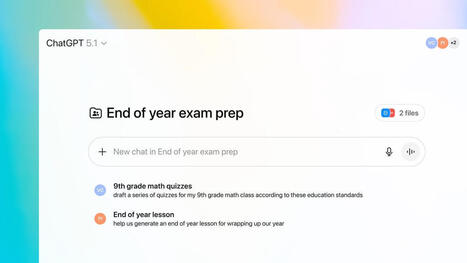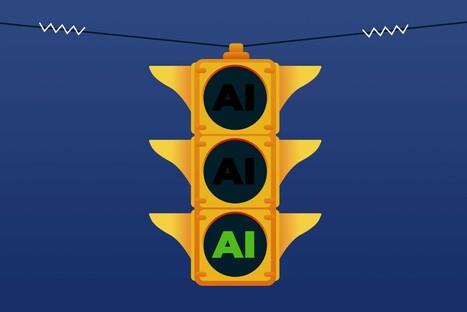 Your new post is loading...
 Your new post is loading...

|
Scooped by
David W. Deeds
Today, 6:26 PM
|
Each year, the pace of change in K-12 education seems to accelerate, and 2026 is no exception. From the expanding influence of artificial intelligence to new expectations for online security and safety, schools are balancing bold innovation with the realities of limited time, resources, and capacity. That’s where CoSN’s Driving…

|
Scooped by
David W. Deeds
December 1, 6:15 PM
|
Teachers share their biggest work-related stressors.

|
Scooped by
David W. Deeds
November 30, 6:02 PM
|
Artificial intelligence is unpopular and uncool — so A.I. companies are making ads that don’t even bother to show their own products. Will it pay off?
Starting with where/how to put “AI in Education” seems to start backwards.
Via EDTECH@UTRGV

|
Scooped by
David W. Deeds
November 25, 6:07 PM
|
From classroom curiosities to the foundations of modern STEM education, robotics and drone technology are reshaping how students learn and think. No longer confined to after-school clubs or science fairs, these tools are helping prepare learners for a world driven by innovation, automation, and data. In today’s K–12 classrooms, robots…
The service is customized for teachers' needs and includes added security and privacy, a collaborative workspace, and more.
Via EDTECH@UTRGV

|
Scooped by
David W. Deeds
November 20, 8:46 PM
|
From construction noise to natural disasters, teachers work to keep students focused through distractions.

|
Scooped by
David W. Deeds
November 20, 1:40 AM
|
AI literacy instruction is embedded across all 10 of the district's high school career pathways.

|
Scooped by
David W. Deeds
November 18, 6:34 PM
|
Two nonprofits teamed up to create a toolkit of resources schools can use to help families.

|
Scooped by
David W. Deeds
November 17, 6:44 PM
|
A CTE expert recommends teachers and students fact check any information or advice AI generates.

|
Scooped by
David W. Deeds
November 17, 6:38 PM
|
Teachers are avoiding important, complex topics because they fear backlash.

|
Scooped by
David W. Deeds
November 14, 6:51 PM
|
As neural implant technology and A.I. advance at breakneck speeds, do we need a new set of rights to protect our most intimate data — our minds?
|

|
Scooped by
David W. Deeds
Today, 1:06 AM
|
Please log in to your CSTA Account to register! CSTA is excited to launch this year’s Computer Science Education Week (December 8–14, 2025) with a dynamic kickoff event! We’re spotlighting how computer science fuels the innovations behind artificial intelligence. As AI reshapes our world, a strong CS foundation isn’t just helpful—it’s essential. Join us as we equip the next generation with the computational thinking and problem-solving skills to lead in AI development and create impactful solutions for the future.

|
Scooped by
David W. Deeds
December 1, 5:45 PM
|
At M.I.T., a new program called “artificial intelligence and decision-making” is now the second-most-popular undergraduate major.

|
Scooped by
David W. Deeds
November 28, 7:21 PM
|
The OpenSimulator Community Conference is an annual conference that focuses on the developer and user community creating the OpenSimulator software. The virtual conference features presentations, workshops, keynote sessions, and social events across diverse sectors of the OpenSimulator user base.
If there’s a single shift the AI tutor brings to lifelong learning, it’s this: learning becomes less about consuming content and more about entering a dialogue. You ask, it responds. You try, it observes. You reflect, it reframes.
Via Nik Peachey, Elizabeth E Charles

|
Scooped by
David W. Deeds
November 25, 12:13 AM
|
Meta announced WorldGen, a new AI tool that could soon let you generate navigable 3D worlds in minutes from a single text prompt. The News Meta Reality Labs announced WorldGen in a blog post, a research-stage system for generating fully navigable, stylistically coherent 3D worlds from a single text prompt. As outlined in WorldGen’s research …
Common Sense Education provides educators and students with the resources they need to harness the power of technology for learning and life. Find a free K-12 Digital Citizenship curriculum, reviews of popular EdTech apps, and resources for protecting student privacy.
Via Dr. Tom D'Amico (@TDOttawa)

|
Scooped by
David W. Deeds
November 20, 7:42 PM
|
OpenSimulator Community Conference!Interested in presenting or volunteering at this year’s event? The annual conference focuses on the developers creating the OpenSimulator software and the user creating the community.

|
Scooped by
David W. Deeds
November 20, 1:24 AM
|
Sixth through 12th grade students are learning all about AI in this district.

|
Scooped by
David W. Deeds
November 18, 6:31 PM
|
A Virginia district strives to teach students that not all AI use amounts to 'cheating.'

|
Scooped by
David W. Deeds
November 17, 6:41 PM
|
As the new trend spreads, teachers are left to wonder—should they stop it or embrace it?

|
Scooped by
David W. Deeds
November 17, 6:13 PM
|
Frustrated by the medical system, some patients are turning to chatbots for help. At what cost?

|
Scooped by
David W. Deeds
from Education 2.0 & 3.0
November 16, 6:20 PM
|
MIT Associate Professor Justin Reich is working to help k-12 educators by listening to and sharing their stories about AI in the classroom.
Via Yashy Tohsaku
|
 Your new post is loading...
Your new post is loading...
 Your new post is loading...
Your new post is loading...





































DRIVING K-12 Innovation Report Top Topics for 2026 announced! The full report will be released in early February after the CoSN (Consortium of School Networking) Summit!